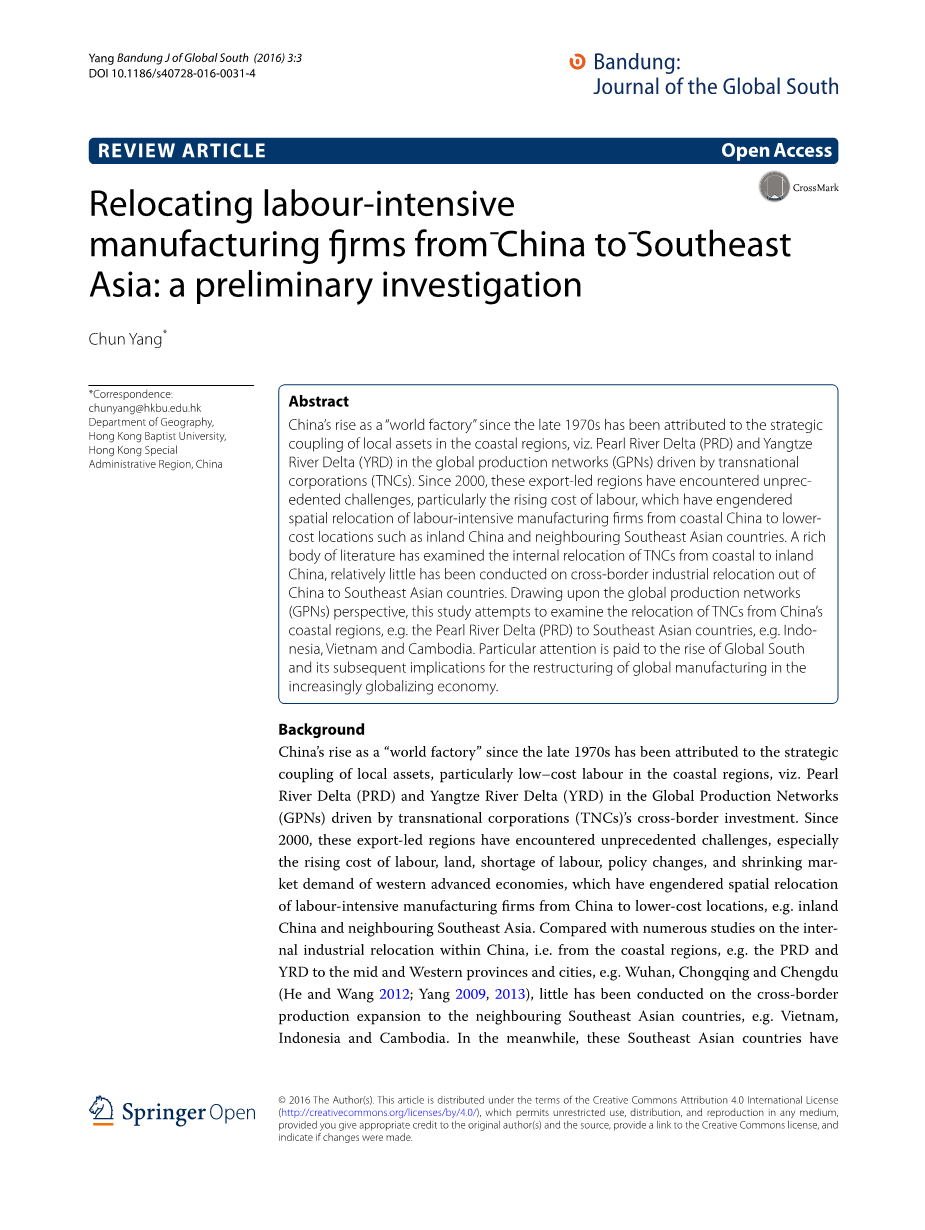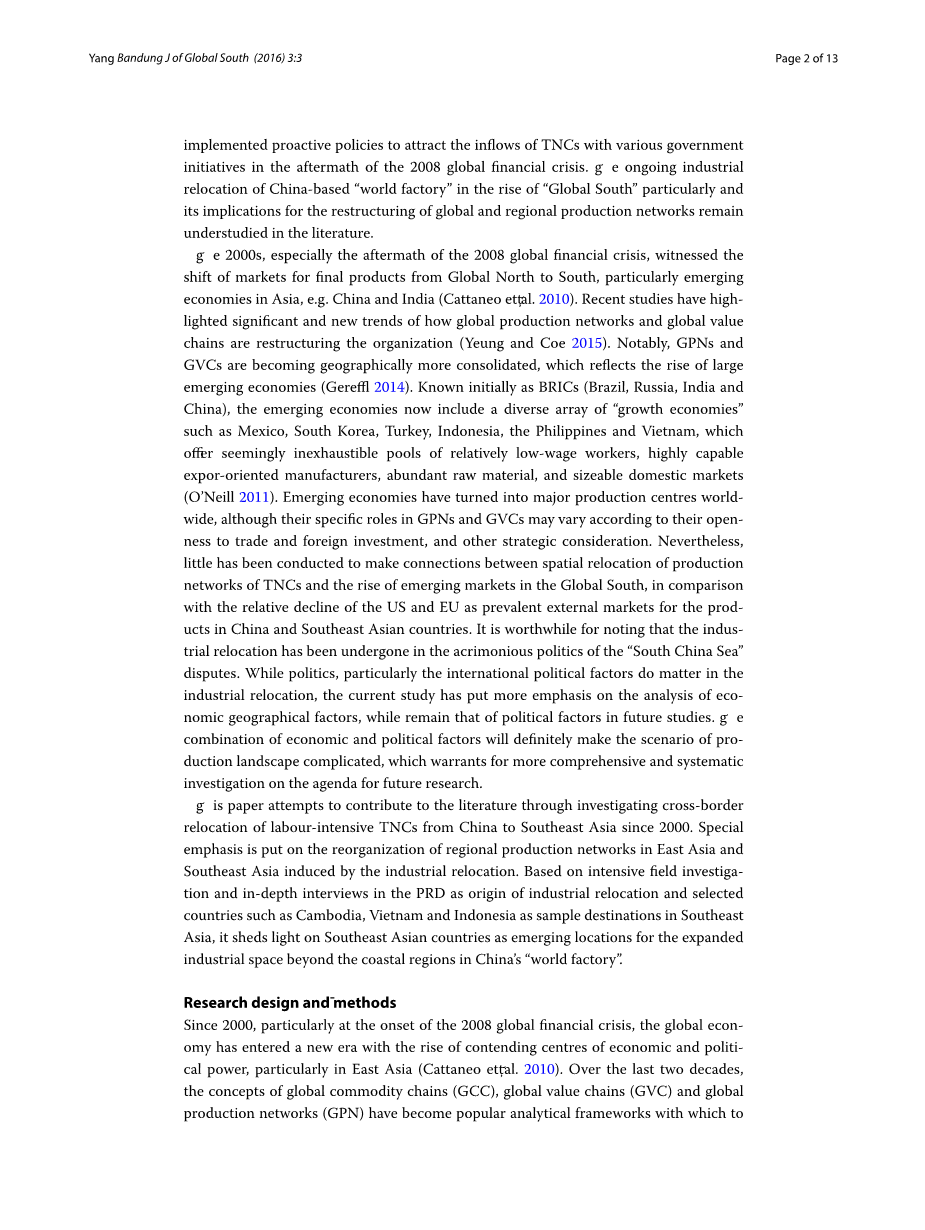

英语原文共 13 页,剩余内容已隐藏,支付完成后下载完整资料
研究设计与方法
自2000年特别是2008年全球金融危机以来,随着竞争激烈的经济和政治权力中心的出现(特别是在东亚),全球经济进入了一个新时代(Cattaneo等.2010).在过去的二十年中,全球商品链(GCC),全球价值链(GVC)和全球生产网络(GPN)的概念已成为热点分析框架,以此来探索经济全球化格局的变化和相关的发展成果(Coe等 .2004,2008;Gereffi等.2005)。从GPN的角度来看,发展中国家的公司已尝试与GPN进行“战略耦合”,以促进区域发展(Yeung 2009).然而,近期研究声称,全球制造网概念无法很好解释,并且未充分考虑动态的去耦合和重新耦合(MacKinnon 2012).在GPNs不断变化的地域性政治经济中,出口导向型地区战略性组合的负面影响或“黑暗面”引起越来越多的关注,例如,过度依赖西方市场(Henderson and Nadvi 2011).最近,有人提出了所谓的“ GPN 2.0”,旨在为不同行业、部门和经济体之间全球制造网络剧烈变动的原因和方式提供新的理论支持(Coe and Yeung 2015)此外,最近提出了“脱钩”和“重新耦合”的概念,用来重新定义全球制造网络中区域经济体的“战略耦合”(MacKinnon 2012).正如Yeung and Coe(2015)指出,“之后可以进行去耦和重新耦合,合并新的组和/或重组区域和GPN中已存在的集团”。通过研究印度的制药业,Horner(Horner 2014)表明,从1947年 到2005年,战略性耦合,脱钩和再偶联的动态过程使印度成为了世界领先的制药生产中心之一。MacKinnon(2012)认为,在西欧和北美的老工业等地区进行结构耦合后,去耦是更有可能的结果。与脱钩论类似,“脱节”是墨西哥拉拉古纳服装行业区域封锁的后果(Bair and Werner 2011).在过去的几十年中,东亚国家已经成功融入全球和区域生产网络,由此诞生了所谓的“三角贸易”模式 (Baldwin and Lopez-Gonzalez 2015):中国作为出口基地,将从亚洲NIE和日本进口的零部件组装成最终产品,供美国和欧盟的外部市场使用。此外,在过去的5年(2009-2014年),越来越多消费品中的贸易额已重新定位:现在,越来越多的最终产品出口到东亚地区的国家(Helble 2014).亚洲尤其是中国的崛起不仅已成为发达经济体的低成本全球供应基础,更重要的是,对以前仅供发达经济体消费的商品和服务产生了新的需求(Kaplinsky 等.2011).自2000年代初以来,尤其是在全球金融危机爆发之初,“脱钩”或东亚与美国和欧洲市场脱钩以及与东亚新兴市场进行“脱钩”的交易引起了广泛关注。(Pula and Peltonen 2009)“脱钩”的概念假定,东亚已经成为一个独立的经济实体,以维持其自身的增长动力而不依赖传统发达市场。在1995年至2008年期间,高收入国家在制造业创造的总价值增量中的份额从74%下降到了56%,日本和东亚NIE的份额则从21%下降到了11%。在同一时期,新兴经济体的制造业增加值份额增加了18%,而仅中国就占了一半增长,其全球份额从4%迅速增加到13%(Timmer等.2014)。
在1970年代后期,东亚新兴工业化国家(NIEs)的出口导向型发展最初被指定为中国的典范,特别是后来的珠三角和长三角。中国的出口型生产区域受益于区域资产(廉价劳动力和土地)的“战略耦合”过程以及通过传导性机构(加工贸易制度)实现的GPN的战略需求(成本降低和上市时间)(杨2012)。但是,自2000年以来,以出口为导向的地区在全球,国家和地方各级都遇到了前所未有的挑战,包括劳动力成本激增,严格的劳动力和环境监管,人民币升值以及西方核心市场需求低迷带来的订单减少(杨2007)。在2008年全球金融危机之前,广东省政府启动了所谓的“放空新鸟笼”战略,通过该战略,劳动密集型和低端跨国公司作为“老鸟”被迫从珠三角迁至欠发达地区,而珠三角将被“新鸟”高科技增值产业取代(杨2012, 2014)。2008年全球金融危机的爆发加速了“世界工厂”的空间“修复”(张2014),其特点是将外向型生产行业转移到低成本地区,包括长三角地区的区域内转移(魏2015),区域间搬迁(杨2009)并扩展到中国内陆(He 等.2011),以及邻近的南亚地区(Zhu and Pickles 2014)。以服装业为例,Zhu and Pickles(2014)将重组过程描述为“向上”,“向西”和“向外”。现有的关于产业转移的文献主要集中在中国内部的产业转移,关于跨境生产向东南亚扩展的研究很少,其对全球和区域生产网络重组的影响缺乏全面和最新的调查。
“亚洲工厂”的概念最初是在1960年代作为制造力量出现的,当时日本开始出口电子产品和消费品,其次是亚洲新兴工业化经济体,分别是台湾,韩国,新加坡和香港。到了1980年代,日本公司在东南亚建立工厂。自从1970年代末实行改革开放以来,中国成为亚洲工厂最具吸引力的地区。亚洲对全球制造业产出的贡献从1990年的26.5%增加到2013年的46.5%。其中,中国占亚洲制造业产出的一半。同时,亚洲在期间产品(组装成最终产品出口到西方先进市场的商品)的全球贸易中所占的份额从2000年的14%上升到2012年的50%(《经济学人》2015)。但是,自2000年以来,中国“世界工厂”的低端制造一直由于上述中国劳动力成本上升,国家产业升级举措和人民币升值幅度不大的因素而减弱。对于目前在中国运营的许多成本敏感的外国公司而言,尤其如此。下图显示了尽管全球经济下滑导致外部需求下降,但从2008年起中国的单位劳动成本仍继续快速增长。与东南亚其他出口经济体相比,中国的单位劳动力成本经历了更为陡峭的攀升(图1).东南亚的迅速崛起提供了一个庞大的劳动力库,工资低廉,而且大多是市场友好型政策环境。中国工厂工人的平均日薪为27.50美元,而同期为8.60美元。
资料来源:Chun Yang. Relocating labour‑intensive manufacturing firms from China to Southeast Asia: a preliminary investigation[J].Journal of Global South.2016,(3):1-13
附原文:
Research design and methods
Since 2000, particularly at the onset of the 2008 global financial crisis, the global economy has entered a new era with the rise of contending centres of economic and political power, particularly in East Asia (Cattaneo et al. 2010). Over the last two decades, the concepts of global commodity chains (GCC), global value chains (GVC) and global production networks (GPN) have become popular analytical frameworks with which to explore the changing landscapes of economic globalization and its associated developmental outcomes (Coe et al. 2004, 2008; Gereffi et al. 2005). From the GPN perspective, firms in developing countries have attempted to engage in “strategic coupling” with GPNs to foster regional development (Yeung 2009). Recent literature, however, argues that the concept is not explanatory enough and does not sufficiently take into account decoupling and recoupling dynamics (MacKinnon 2012). In the changing geographical political economy of GPNs, increasing attention has been paid to the negative effects, or “dark sides” of strategic coupling of export-oriented regions, e.g. over reliance on the Western markets (Henderson and Nadvi 2011). Recently, the so-called “GPN 2.0” was proposed to offer novel theoretical insights into why and how the organization of global production networks varied significantly within and across different industries, sectors and economies (Coe and Yeung 2015). Moreover, the concepts of “decoupling” and “recoupling” have been recently proposed to refine the strategic coupling of regional economies in GPNs (MacKinnon 2012). As put Yeung and Coe (2015), “Processes of decoupling and recoupling can takeplace thereafter, incorporating new groups and/or recombining existing groups of regional and GPN actors”. By examining Indiarsquo;s pharmaceutical industry, Horner (Horner 2014) demonstrated that the dynamic process of strategic coupling, decoupling and recoupling between 1947 and 2005 enabled India to become one of the worldrsquo;s leading centres for pharmaceutical production. MacKinnon (2012) contends that decoupling is a more likely outcome after structural coupling in those places such as old industrial regions in Western Europe and North America. Similar to the thesis of decoupling, “disarticulation” has emerged in the severe consequences of regional lock-in in the apparel industry in La Laguna, Mexico (Bair and Werner 2011).
Over the past decades, countries in East Asia have been successful in joining global and regional production networks, which has led to a so-called “triangular trade” pattern (Baldwin and Lopez-Gonzalez 2015): China as an export base to assemble components and parts imported from Asian NIEs and Japan into final goods for external markets in the US and EU. Moreover, an increasing share of trade in consumption goods has become reoriented over the past 5 years (2009–2014): more final goods are now being exported to countries within East Asia (Helble 2014). The r
剩余内容已隐藏,支付完成后下载完整资料
资料编号:[245616],资料为PDF文档或Word文档,PDF文档可免费转换为Word
以上是毕业论文外文翻译,课题毕业论文、任务书、文献综述、开题报告、程序设计、图纸设计等资料可联系客服协助查找。


